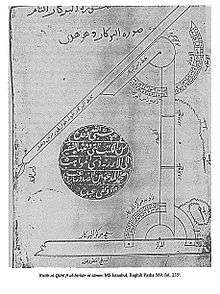'Abd al-Hamīd ibn Turk
ʿAbd al-Hamīd ibn Turk (fl. 830), known also as ʿAbd al-Hamīd ibn Wase ibn Arab Jili was a ninth-century Turkic Muslim mathematician. Not much is known about his biography. The two records of him, one by Ibn Nadim and the other by al-Qifti are not identical. However al-Qifi mentions his name as ʿAbd al-Hamīd ibn Wase ibn Turk Jili. Jili means from Gilan.[1] His surname Turk makes it clear that he is of Turkic heritage.
He wrote a work on algebra of which only a chapter called "Logical Necessities in Mixed Equations", on the solution of quadratic equations, has survived.
He authored a manuscript entitled Logical Necessities in Mixed Equations, which is very similar to al-Khwarzimi's Al-Jabr and was published at around the same time as, or even possibly earlier than, Al-Jabr.[2] The manuscript gives exactly the same geometric demonstration as is found in Al-Jabr, and in one case the same example as found in Al-Jabr, and even goes beyond Al-Jabr by giving a geometric proof that if the discriminant is negative then the quadratic equation has no solution.[2] The similarity between these two works has led some historians to conclude that algebra may have been well developed by the time of al-Khwarizmi and 'Abd al-Hamid.[2]
References
- ↑ Ibn Turk in Dāʾirat al-Maʿārif-i Buzurg-i Islāmī, Vol. 3, no. 1001, Tehran. To be translated in Encyclopædia islamica.
- 1 2 3 Boyer, Carl B. (1991). "The Arabic Hegemony". A History of Mathematics (Second ed.). John Wiley & Sons, Inc. p. 234. ISBN 0-471-54397-7.
The Algebra of al-Khwarizmi usually is regarded as the first work on the subject, but a recent publication in Turkey raises some questions about this. A manuscript of a work by 'Abd-al-Hamid ibn-Turk, entitled "Logical Necessities in Mixed Equations," was part of a book on Al-jabr wa'l muqabalah which was evidently very much the same as that by al-Khwarizmi and was published at about the same time – possibly even earlier. The surviving chapters on "Logical Necessities" give precisely the same type of geometric demonstration as al-Khwarizmi's Algebra and in one case the same illustrative example x2 + 21 = 10x. In one respect 'Abd-al-Hamad's exposition is more thorough than that of al-Khwarizmi for he gives geometric figures to prove that if the discriminant is negative, a quadratic equation has no solution. Similarities in the works of the two men and the systematic organization found in them seem to indicate that algebra in their day was not so recent a development as has usually been assumed. When textbooks with a conventional and well-ordered exposition appear simultaneously, a subject is likely to be considerably beyond the formative stage. ... Note the omission of Diophantus and Pappus, authors who evidently were not at first known in Arabia, although the Diophantine Arithmetica became familiar before the end of the tenth century.
- Høyrup, J. (1986). "Al-Khwarizmi, Ibn Turk and the Liber Mensurationum: On the Origins of Islamic Algebra". Erdem. 5: 445–484.
- Sayili, Aydin (1962). Abdülhamit İbn Türk'ün Katışık Denklemlerde Mantıki Zaruretler Adlı Yazısı ve Zamanın Cebri. (Logical necessities in mixed equations by ʿAbd al Hamīd ibn Turk and the algebra of his time.). Ankara: Türk Tarih Kurumu Basımevı. Rev. by Jean Itard in Revue Hist. Sci. Applic., 1965, I8:123-124.
